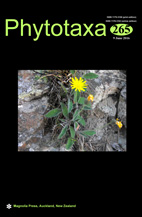Abstract
We describe a new diatom species of the genus Eunotia from a karst pond in Maolan Town, a karst area in Moalan Nature Reserve, Guizhou Province, China, using light and scanning electron microscopy. The species is similar to Eunotia sudetica, differing in size and shape of the valves. Externally, the new species has striae contained in shallow, irregularly-shaped channels and individual areolae have narrow openings due to the presence of rimmed occlusions. A large external opening of the rimportula occurs at one end of each valve. Internally, the new species has alveoli covering the areolae, the alveoli are partial in some specimens, present only in the middle of the valve while they extend from the dorsal margin to the ventral margin in other specimens. This species has a large rimportula and pseudosepta. In addition to the differences in extent of the alveoli, specimens differ in that some are proportionately wider than others, in the narrower valves small spines are consistently present as well as a few, shortened striae on the dorsal margin. We compare this new species with others in the genus based on its morphological features, and note similar internal alveoli in a species assigned to the genus Fragilariforma.

